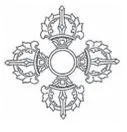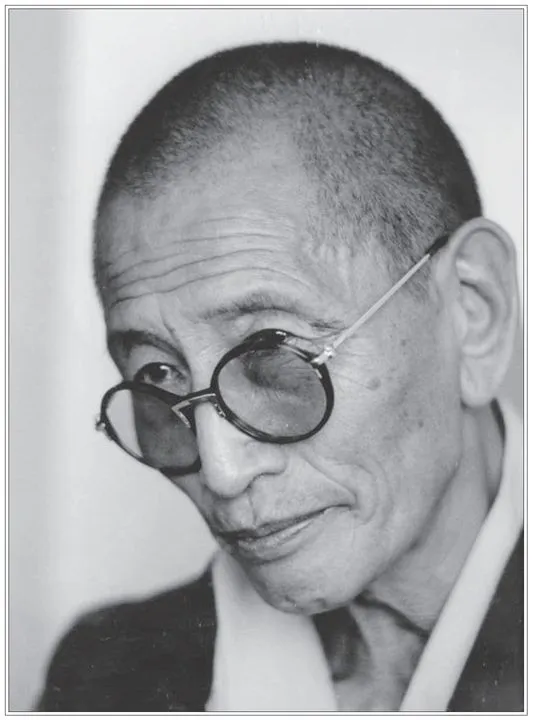![]()
PART I
The Three Lower Tantras
dp n="27" folio="20" ?
Kirti Tsenshap Rinpoche, circa 1992, Nepal.
dp n="28" folio="21" ? ![]()
ONE
Action Tantra
How to progress on the path of action tantra This has four divisions: 1. How to become a vessel suitable for meditating on the path
2. How to keep the vows and commitments purely after becoming a suitable vessel
3. How to approximate the deity while keeping the commitments
4. How to establish the siddhis having achieved approximation
How to become a vessel suitable for meditating on the path First train your mind well in the shared paths according to the Great Stages of the Path and the Condensed Stages of the Path. Then enter the maṇḍala of any of the three lineages of action tantra and receive empowerment in reliance on a qualified vajra master and in accord with the explanations of the different classes of tantra.
First we are advised to train our mindstream by following the paths shared by sūtra and tantra, and then to find a qualified tantric master. One of the first subjects discussed in the stages of the path (
lamrim) literature is the way to properly rely on a qualified teacher and the need to examine any potential tantric master fully before requesting tantric empowerment. There are different sets of qualities we should examine before relying on a teacher. The
Guru Pūjā lists the qualities of teachers of Vinaya (monastic discipline), Mahāyāna, and tantra in three separate verses. Verse 43 emphasizes the importance of moral discipline and stability in a teacher of Vinaya:
13 We make requests to the elders who maintain Vinaya,
who are born from an array of jewels of extensive study
within the great ocean of ethics that is the source of good qualities
and who are lords clad in saffron, like the second appearance of Munīndra.
Verse 44 expresses the qualities of a Mahāyāna teacher according to the stages of the path:
14 We make requests to spiritual friends of the Supreme Vehicle,
who possess ten qualities and are qualified to teach
the paths of the sugatas to those who are suitable,
and who as lords of Dharma possess the entire heritage of the conquerors.
Verse 45 summarizes the qualities of a tantric master:
15 We make requests to the supreme holder of the vajra,
who possesses both sets of ten qualities, including restraint of the three doors,
great mind, patience, integrity, freedom from pretension and deceit,
knowledge of mantra and tantra, and skill in composition and explanation.
A tantric master has “skill in composition and explanation” since he is expert in explaining and composing tantric texts and commentaries. Further he should possess a complete knowledge of the tantric rituals that are specific to each tantra, such as the complex and unique rituals of Kālacakra.
dp n="30" folio="23" ?Thus having trained our minds, found a qualified master, and requested empowerment, we should then enter the maṇḍala of any of the lineages of action tantra and receive empowerment. We should ideally receive empowerment in all three lineages, but it is said that we may enter the maṇḍala of any one of the three lineages.16 Within action tantra the three lineages are (1) the tathāgata, (2) the lotus, and (3) the vajra. Each lineage includes a vast number of deities, and in general Mañjuśrī is regarded as the protector of the tathāgata lineage, Avalokiteśvara the protector of the lotus lineage, and Vajrapāṇi the protector of the vajra lineage. Even so, Avalokiteśvara, Mañjuśrī, and Vajrapāṇi also exist within the other three classes of tantra, namely performance, yoga, and highest yoga tantra.
Types of maṇḍalas Question: In what maṇḍala is the empowerment bestowed?
Reply: The empowerment may be bestowed in a colored-sand or painted-cloth maṇḍala. For some special beings it is conferred in an absorption maṇḍala.
In general, a suitable candidate may receive empowerment in either (1) a sand maṇḍala made of colored granules or (2) a painted-cloth maṇḍala. Some special beings may receive initiation in (3) an absorption maṇḍala, where empowerment is conferred on the basis of a maṇḍala established through the meditative projection of both the tantric master and the student.
In action [2b] tantra there is no body maṇḍala and so on. Even the terms body maṇḍala, relative-bodhicitta maṇḍala , lotus maṇḍala, and ultimate-bodhicitta maṇḍala are not used in the three lower classes of tantra because these four maṇḍalas are features of highest yoga tantra alone.
Thus in action tantra, empowerment can only be bestowed in three types of maṇḍala, namely the (1) sand, (2) painted-cloth, and (3) absorption maṇḍalas. The four other types of maṇḍalas—the body maṇḍala,17 the relative-bodhicitta maṇḍala, the lotus maṇḍala, and the ultimate-bodhicitta maṇḍala—are not used in the lower tantras, and even their names are not mentioned. Such maṇḍalas are found only in highest yoga tantra. Thus highest yoga tantra employs seven types of maṇḍala while the lower tantras use only the first three.
The type and number of empowerments Question: What empowerments are bestowed?
Reply: Only the vase empowerment is bestowed. The three higher empowerments do not exist in the three lower classes of tantra.
The term empowerment implies granting permission to engage in certain activities. In secular life as well as in Dharma practice, our level of skill tends to determine our level of authorization, and improvement in skills leads to higher authorization, granting us access to more areas and activities. In general there are three types of empowerment: the maturing causal empowerment, the liberating path empowerment, and the liberated resultant empowerment.
The maturing causal empowerment grants permission to practice a particular deity, and this is obtained during the initiation ceremony. At that time, the minds of students are matured by hearing the words of the initiating master as he guides students through the initiation ceremony of that deity.18 The ritual itself acts as the cause of maturation. Students obtain the liberating path empowerment by progressing through the learner paths. By obtaining the wisdom derived from study, the wisdom derived from contemplation, and finally the wisdom derived from meditation on the deity, they obtain, respectively, the path of accumulation, the path of preparation, and the paths of seeing and meditation of this particular tantra. When the students obtain the non-learner path—the path of no-more learning—they obtain the liberated resultant empowerment that is the highest level of authorization.
The second issue this verse raises is the number of empowerments received, and again there is a difference between the three lower tantras and the highest yoga tantra. In highest yoga tantra there are four empowerments—the vase, secret, pristine wisdom, and word empowerments—but in the lower tantras only the vase empowerment is bestowed.
There is a difference in the number of empowerments bestowed in the four classes of tantra. Action tantra has just the water and crown empowerments and the presentation of ritual objects at the end of the ceremony.
In action tantra initiation is conferred by the water and crown empowerments 19 that are included within the vase empowerment. Tsongkhapa states that in the water empowerment, the water in the vase is generated as the deity, and the empowerment is given on the basis of that blessed water. In the crown empowerment, each of the five facets of the crown is adorned with the emblem of one of the five buddha families, and empowerment is bestowed after invoking the buddhas of the five families, each of whom blesses his respective emblem. These two empowerments are followed by the presentation of certain ritual objects at the end of the ceremony.20 The term just emphasizes that only a small number of initiations are given, and this indicates the relative lack of maturity of those taking the initiation.
Performance tantra has just five knowledge empowerments, consisting of the former two plus the vajra, bell, and name empowerments, as well as the presentation of ritual objects at the end.21 Yoga tantra has just these plus the vajra-master empowerment, as well as the presentation of ritual objects at the end.
In brief the number of empowerments increases from two empowerments in action tantra, to five in performance tantra, to six in yoga tantra. These six empowerments, collectively called the vase empowerment, together constitute the first of the four empowerments of highest yoga tantra. In other words, if we obtain the water, crown, vajra, bell, name, and vajra-master empowerments, we obtain the vase empowerment.22
dp n="33" folio="26" ?Highest yoga tantra has four empowerments consisting of that empowerment plus the three higher empowerments.
Full initiation into highest yoga tantra requires, in other words, the vase empowerment plus the secret, pristine wisdom, and word empowerments.
Kālacakra as a specific highest yoga tantra has sixteen empowerments—seven emulating childhood, four higher empowerments, four highest empowerments, and the empowerment of the great lord vajra master.
The Kālacakra tantra possesses a unique system of enumerating the empowerments. If empowerment is given according to the system of Śrī Abhayākaragupta, they may be bestowed on the basis of a painted-cloth maṇḍala in which only the four empowerments are received. But when empowerment is obtained on the basis of a sand maṇḍala, there are, according to the instruction of Tsongkhapa, a total of sixteen empowerments. First (1–7) the group of seven empowerments emulating childhood are bestowed, then the four higher empowerments that include (8) the higher vase, (9) the higher secret, (10) the higher pristine-wisdom, and (11) the higher word empowerments, then the four highest empowerments are bestowed, namely (12) the highest vase, (13) the highest secret, (14) the highest pristine-wisdom, and (15) the highest word empowerments, and finally (16) the great lord vajra-master empowerment.
Since the four higher and the four highest empowerments are similar, they can be grouped together. The higher vase empowerment can be grouped with the highest vase empowerment, the higher secret with the highest secret empowerment, and the higher pristine-wisdom empowerment with both the highest pristine wisdom and the higher word empowerment. The highest word empowerment stands alone. This alternate method of enumeration therefore has twelve components: (1–7) the seven empowerments emulating childhood, (8–10) seven empowerments condensed into three (vase, secret, and pristine wisdom), (11) the highest word empowerment, plus (12) the great lord vajra-master empowerment.
Still, the Vajra Garland of Maṇḍala Rites explains that five knowledge empowerments are bestowed in a...


